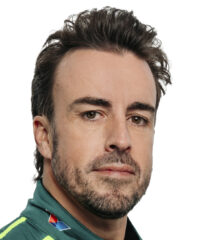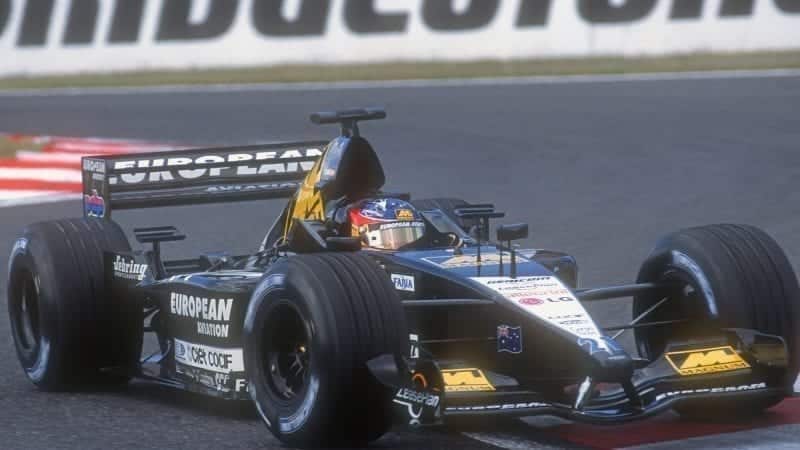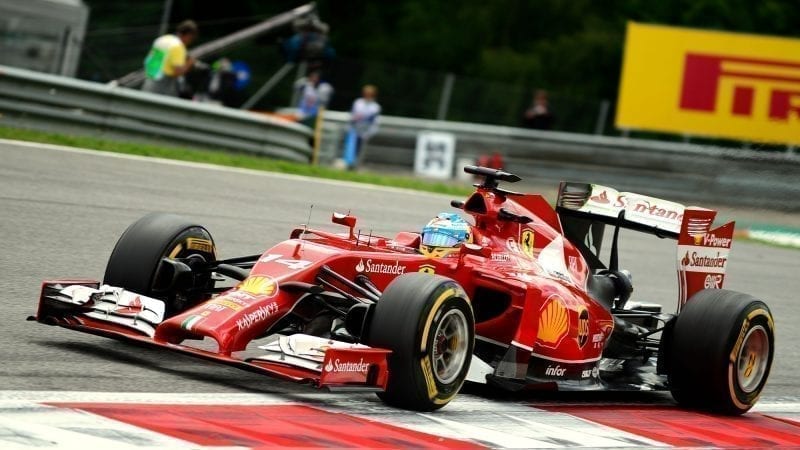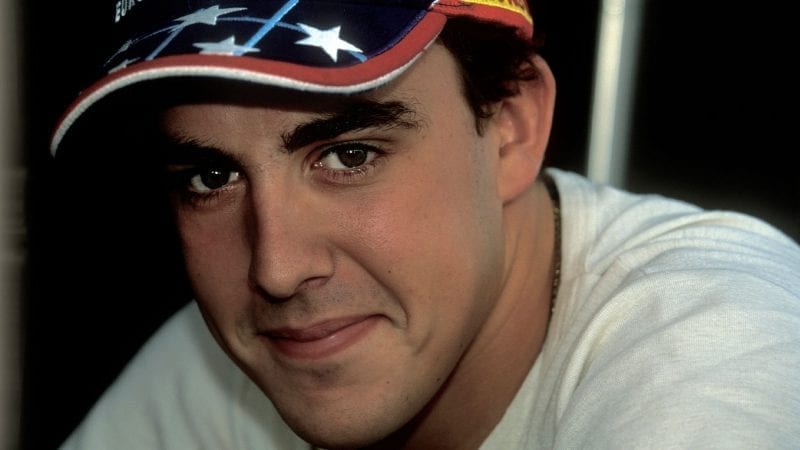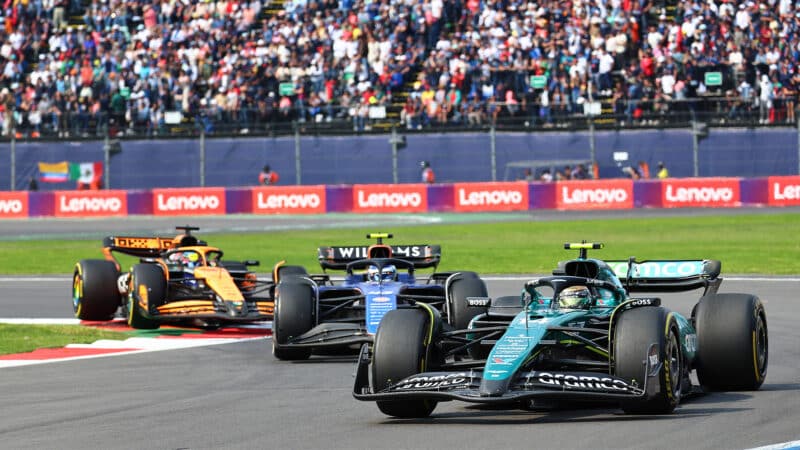That F1 had a new superstar was confirmed as Alonso retained his title in 2006 despite it already being known that he would be moving on at the end of the year. There was the destabilising mass damper ban and Alonso was unfairly penalised during qualifying at Monza but team and driver resolutely focused on winning again. Winner of six of the opening nine races (and always in the top two), Alonso withstood Michael Schumacher’s mounting challenge and responded to those controversies. He won again in Japan and clinched a second title at the final round.
McLaren and a return to Renault
Alonso made his long-anticipated move to McLaren Mercedes in 2007 at the start of a three-year contract. In the event, it was an unhappy arrangement that lasted just one season. His relationship with senior management soon soured just as rookie team-mate Lewis Hamilton charged onto the scene with the swagger of a champion in waiting. Any fragile accord with the team was fractured – apparently forever – when Alonso deliberately scuppered Hamilton’s qualifying in Hungary. Furthermore, the team was by then embroiled in the “Spygate” affair having been found to be in possession of a dossier of Ferrari intellectual property. That said, four victories maintained Alonso’s challenge to the final round but both he and Hamilton eventually fell a point short of Ferrari’s Kimi Räikkönen in the championship chase – Alonso officially third in the standings on countback.
With his reputation tarnished and McLaren contract ended by mutual consent, Alonso returned to Renault for 2008. That was amid rumours about whether the French team remained committed to F1 so successive victories in Singapore and Japan were welcome indeed. However, that former success proved a controversial affair. Team-mate Nelson Piquet jr later admitted to crashing on purpose to trigger a safety car that effectively handed Alonso victory. Flavio Briatore and Pat Symonds were later sanctioned by the FIA for their roles in “Crashgate” but Alonso was not implicated in the latest F1 scandal.
Alonso did not win a race during 2009 and third in Singapore – ironically enough – was scene of his only podium finish of the year. The Renault R29 was simply no match for Red Bull or new champions Brawn-Mercedes-Benz and Alonso finished a lowly ninth in the standings. Despite that disappointing return and the recent controversies that had surrounded him, the belief in the paddock remained that Alonso was the very best.
Ferrari – in search of a third title
That led Ferrari to ease Räikkönen out of the team a year before his contract expired and hire Alonso as its star driver from 2010. Despite the Ferrari F10 being no match for either of its rivals from Red Bull and McLaren, Alonso won five times during his maiden season with the Scuderia to lead the points before the final GP in Abu Dhabi. He inherited victories in the opening race in Bahrain and in the wet Korean GP and was gifted the German GP by team-mate Felipe Massa. That led to Ferrari being fined $100,000 for imposing team orders. However, back-to-back wins in Italy (Ferrari’s first in front of the Tifosi since 2006) and Singapore were virtuoso Alonso – withstanding pressure from faster cars on both occasions. In the event, a tactical error during the final race left Alonso mired behind Vitaly Petrov’s sixth placed Renault. That handed the World Championship to Sebastian Vettel with Alonso finishing as runner-up.
Rather than build on having gone so close a year before, the conservative new F150 proved so disappointing that Ferrari soon restructured its technical team. He defied the car’s pace to lead in Barcelona and mid-season upgrades improved matters somewhat. Alonso took advantage of Red Bull pit errors to score the team’s only win at Silverstone – one of 10 podium finishes – as he came fourth in the 2011 standings. Knowing that he had dragged everything and a little more from his car, Ferrari extended Alonso’s contract until 2016.
Under pressure to produce a championship-winning package, the radical Ferrari F2012 was initially off-the-pace although Alonso still managed to win the wet Malaysian GP and score an emotional victory at Valencia. He then converted back-to-back pole positions in Britain and Germany into second place and a third win respectively to establish himself in a clear points lead. However, eliminated at Spa-Francorchamps and Suzuka after being hit by rivals, Alonso was unable to wrestle the title from Vettel – losing out at the final round by just three points and runner-up once more.
The 2013 season began well with Alonso’s Ferrari F138 winning the Chinese and Spanish GPs although his campaign, and his relationship with the team, was soon on the wane. He consistently finished in the points but could not match the pace of Vettel’s Red Bull – especially in qualifying – and he did not win again. Alonso split the Red Bulls in the final standings as he finished as runner-up behind Vettel for a third time, albeit by some margin this year. However, his frustration with the team’s inability to produce a championship-winning package came to the surface.
Alonso was joined by the returning Räikkönen in 2014 but Ferrari endured its first winless season since 1993. Its new turbocharged engine was no match for the Mercedes-Benz and Alonso could only finish sixth overall. That he scored three times the points of Räikkönen and beat his team-mate 16-3 in qualifying illustrated that Alonso was still outperforming the machinery at his disposal. He finished second in Hungary after being passed by Daniel Ricciardo’s Red Bull in the closing stages but the Alonso/Ferrari love affair was over.
Frustration with McLaren-Honda
Replaced by Vettel for 2015, Alonso had little option than to make a surprise return to McLaren at the beginning of its partnership with Honda. Pre-season testing was marred by reliability issues while trying to develop the new Honda unit and a testing crash at Barcelona that forced him to miss the opening race. Off the pace when he did return, the team endured an uncompetitive campaign with straightline speed such that Alonso labelled the power train a “GP2 engine” during the Japanese GP. It was round nine before he even scored a point and fifth next time out in Hungary was the best finish of a torrid season.
McLaren-Honda showed some improvement in 2016 and it was Alonso who led the team’s gradual climb up the constructor standings. The year start with a frightening crash in Australia and the FIA forced him to miss the subsequent Bahrain GP as a precaution. But he out-qualified team-mate Jenson Button 15-5 and finished in the points on nine occasions. That included coming fifth in Monaco and the United States as he dragged the best from the MP4/31. Tenth in the championship may not be the limit of Alonso’s ambitions, but it represented progress at least.
Starring at Indianapolis
Any hope that Honda had finally turned the competitive corner was dashed as soon as the 2017 McLaren MCL32 first ran. The poor straightline speed and unreliability were if anything worse than before but Alonso regularly dragged more performance from his machinery than it deserved. He qualified seventh in Spain, finished sixth in Hungary (where he set the fastest race lap) and lost a possible podium when eliminated at the start of the Singapore GP.
He missed the Monaco GP so that he could make his debut in the Indianapolis 500 where he was impressive all month in an Andretti Autosport-run, McLaren-entered Dallara-Honda. Despite being new to ovals, he qualified the papaya orange car in the middle of the second row and led for 27 laps before his engine blew with 21 laps to go. A contender for victory all day, Alonso’s first appearance at the Brickyard was one of the stories of 2017. His return in 2019 proved an embarrassing anti-climax. McLaren set up its own team with support from Carlin but could not extract enough speed from its Dallara-Chevrolet for Alonso to qualify.
Formula 1 farewell and sports car success
Frustrated by three seasons without success, McLaren switched to Renault engines in 2018 without discernible improvement. Alonso finished fifth in the opening race in Australia and managed to score points on nine occasions. He also out-qualified team-mate Vandoorne at every race but he announced that he would not race in F1 in 2019. Alongside that final F1 season, Alonso raced for the all-conquering Toyota team in the 2018/19 World Endurance Championship. Sharing a Toyota TS050 Hybrid with Sébastien Buemi and Kazuki Nakajima, they won at Spa-Francorchamps before leading a dominant 1-2 in the all-important Le Mans 24 Hours. Winner of the 2019 Daytona 24 Hours for Wayne Taylor Racing, his Toyota success continued for the remainder of the 2018/19 “super season.”
Alonso, Buemi and Nakajima won at Sebring, Spa-Francorchamps and again at Le Mans to be crowned World Champions for 2018/19. With Le Mans ambitions satisfied, Alonso announced he was going to compete on the 2020 Dakar Rally with Toyota. The Spaniard finished 13th but had his sights elsewhere soon enough.
After missing out on the Indy 500 win in 2020, Alonso’s attention turned back to Formula 1 and the Spaniard was confirmed as returning to the series with the same team he won both of his titles with in ’05 and ’06.
Return to Renault power falls short
Similarly to his years at McLaren, Alonso was often held back by factors out of his control, as the Renault owned Alpine failed to find long-term solutions for reliability and performance.
In 2021, Alpine were unable to close the gap to rivals McLaren, narrowly beating AlphaTauri to fifth in the constructors’ standings. This ultimately meant Alonso was unable to compete at the front of the field on a regular basis, but did complete a standout drive in Qatar to capture his first podium since 2014, finishing tenth in the drivers’ standings.
2022 was no more fruitful, with Alonso failing to reach the chequered flag at six grand prix and only finishing as high as fifth despite Alpines elevated performance. The Spaniard did have some positive performances, with fifth place finishes at Silverstone and Spa but it wasn’t enough to entertain a contract extension.
Frustrated and with annoyances with teammate Esteban Ocon beginning to surface, Alonso made the decision to move Aston Martin for 2023, replacing the retiring Sebastian Vettel.
A brilliant return to the front
Alonso looked a racer reborn in 2023, as at the centre of Lawrence Stroll’s new-look Aston Martin squad, the grid’s eldest statesman flourished.
On debut for the Silverstone based outfit at the season opener in Bahrain, Alonso qualified fifth and carved his way through the grid to third — pulling off a overtake-of-the-year-worthy move on Lewis Hamilton as he went.
Over the following 21 rounds, Alonso scored another seven podium finishes, scored 206 points and secured fourth in the drivers’ standings, narrowly beating Charles Leclerc, Lando Norris and Carlos Sainz.
In 2024, Alonso continued to demonstrate his brilliance — even without the neccassary machinery. While Aston’s on-track performance took a step backwards, the Spaniard finished outside the points on only nine occassions and ensured that Aston Martin retained its place as the fifth-fastest constructor.
Heading into 2025, many are excited by Alonso’s partnership with the inbound Adrian Newey — a legendary car designer who could finally deliver the Spaniard some title-contending machinery.
